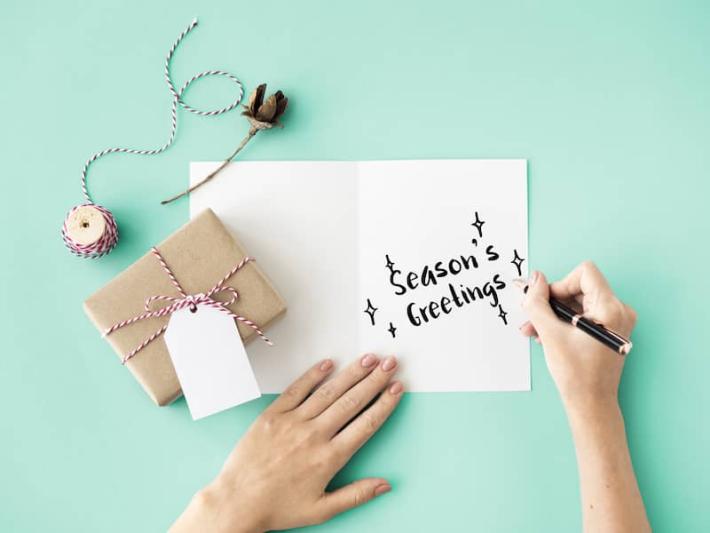Greeting Card Grammar
Make sure your cards, invitations, and yearly newsletters are error-free this year.
Mignon Fogarty

If you’re getting ready to write your holiday newsletter, cards, or invitations, I’m here to help you avoid some of the most common problems!
Making names that end in -s or -z plural
Making names plural is one of the most common questions to come up around the holidays.
Some names are easy, like “Brown.” You just add an -s like you would to any common noun. “The Browns invite you to dinner.”
But when you get to names that end in -s, -z, -ch, -sh, and -ss, it gets trickier.
Fortunately, the same rule applies for all these names: you add -es to make them plural.
- The Joneses are coming for dinner.
- The Alvarezes always decorate their house beautifully.
- The Birches make the best cinnamon apple cake.
- The Marshes make all their own gifts.
- The Besses love to have people over for the holidays.
Making names that end in -y and -i plural.
People also sometimes wonder how to make names that end in -y or -i plural, like my last name, Fogarty.
They’re both the same as those easy names, like Brown: you just add an -s.
- The Fogartys meant to decorate their tree on Thanksgiving, but didn’t get around to it. F-O-G-A-R-T-Y-S (not -ies as people are sometimes tempted to write).
- The Aldis are making pasta with fish on Christmas Eve. A-L-D-I-S. (And—side note—both words of “Christmas Eve” are capitalized because it’s a holiday.)
Don’t use an apostrophe to make names plural
You don’t use an apostrophe to make names plural.
You use an apostrophe to make names possessive, and when the name is already plural, you just put an apostrophe on the end, no extra -s.
For example, let’s say you went to visit the Alvarezes, and then you wanted to write to tell your mom about their wonderful house. To make “Alvarezes” possessive, you add an apostrophe to the end, so you would write, “Mom, you should have seen the Alvarezes’ house!”
- The Birches’ cake is the best.
- The Besses’ decorations are always stunning.
- The Marshes’ party got canceled at the last minute.
- The Joneses’ children are coming home for break this year.
Compound Possession and Apostrophes
Next, we’ve talked about this before, but compound possession can come up in invitations, so I’ll go over it again. Imagine that Aardvark and Squiggly live in the same house, and they are inviting people over for dinner. The location you are inviting people to is Aardvark and Squiggly’s house—with only one apostrophe-s on “Squiggly’s,” the last name in the set. Because they share the house, they share one apostrophe-s.
If Aardvark and Squiggly live in different houses, and they are having a progressive dinner where people go from one house to the next for different courses of a meal, then the location on the invitation would read “Aardvark’s and Squiggly’s houses.” They don’t share the house, so they can’t share an apostrophe-s. Both names need an apostrophe-s: Aardvark’s and Squiggly’s houses.
Punctuating salutations
Next, if you’re writing an end-of-the-year letter, you might be interested in a bet that Laura and her husband John asked me to settle. Their question is how to write a salutation: Do you write something like “Hi, Squiggly” or “Hi Squiggly”?
It seems straightforward, but unfortunately, it’s not. Although most people seem to think “hi” is just a friendly substitute for “dear,” it’s not. “Dear” is an adjective, but “hi” is an interjection just like the words “yes,” and “oh.”
Technically “Hi, Squiggly” is a complete sentence that begins with an interjection, and an interjection at the beginning of a sentence is followed by a comma. So the correct way to write this is “Hi, Squiggly.” You could also put an exclamation point at the end, depending on how excited you feel about the greeting. And this is also called the rule of direct address or the vocative comma.
The problem is that almost nobody knows that greetings should be punctuated this way, so it looks weird when you do it right. In fact, it’s rare to see an e-mail salutation that uses a comma after the “hi.”
I’m always torn about whether to use the comma. It is correct, but it feels pedantic given the widespread use of the incorrect alternative —especially when you are replying to someone who has already done it the “wrong” way. Use your own judgment. I usually put it in, but I do it grudgingly and mostly out of habit these days, and you’ll be in good company if you leave it out.
Dear Squiggly, (correct)
Hi, Squiggly. (correct)
Hi Squiggly, (widespread to the point of becoming acceptable)
How to write holiday words and greetings
Finally, I mentioned already that “Christmas Eve” is capitalized, and I’ll end with some other holiday-related words.
“Hanukkah” is also capitalized, but it has multiple spellings. The AP Stylebook and The Chicago Manual of Style recommend H-A-N-U-K-K-A-H, so that’s what I use.
“Yuletide” and “Christmastime” are both one word and are both capitalized.
“New Year’s Eve” and “New Year’s Day” are both capitalized and both have apostrophes in the word “Year’s.” “New Year’s resolution” also has an apostrophe, but the word “resolution” is lowercase.
“Season’s greetings” also takes an apostrophe.
Whatever holidays you celebrate, I hope they are happy.
Grammar Gift Ideas
This week’s podcast is sponsored by, well, me! If you’re looking for a stocking stuffer, please consider Grammar Girl’s Quick and Dirty Tips for Better Writing or The Grammar Devotional. They make great gifts for the teacher or language lover on your list.
If you want a different kind of gift, I’ve also created T-shirts with fun grammar slogans such as To Infinitives and Beyond.
Image courtesy of Shutterstock.

